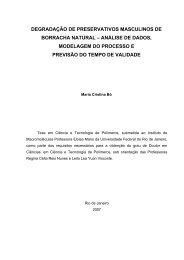EXAFS as a tool for catalyst characterization: a review of the ... - INT
EXAFS as a tool for catalyst characterization: a review of the ... - INT
EXAFS as a tool for catalyst characterization: a review of the ... - INT
You also want an ePaper? Increase the reach of your titles
YUMPU automatically turns print PDFs into web optimized ePapers that Google loves.
from <strong>the</strong> absorber atom and Σ <strong>the</strong> summation extends over j<br />
coordination shells, <strong>the</strong> term e -2rj/λ is due to inel<strong>as</strong>tic losses, Aj(κ ) is<br />
<strong>the</strong> backscattering amplitude from each <strong>of</strong> <strong>the</strong> N j neighboring atoms<br />
and φ j(κ ) is <strong>the</strong> ph<strong>as</strong>e shift between <strong>the</strong> incident and backscattering<br />
wave given by<br />
φ (κ ) = φ a(κ ) + φ b(κ ) (7)<br />
where φ a(κ ) is <strong>the</strong> ph<strong>as</strong>e shift due to <strong>the</strong> central atom and φ b(κ ) is<br />
<strong>the</strong> ph<strong>as</strong>e <strong>of</strong> <strong>the</strong> backscattering amplitude from <strong>the</strong> neighbor.<br />
Multiple scattering effects have been ignored in <strong>the</strong> derivation <strong>of</strong> eq.<br />
6. Fur<strong>the</strong>rmore, since <strong>the</strong> intensity <strong>of</strong> <strong>the</strong> outgoing wave decre<strong>as</strong>es<br />
very f<strong>as</strong>t with incre<strong>as</strong>ing R, <strong>the</strong>re is very little contribution to <strong>the</strong> fine<br />
structure <strong>of</strong> <strong>the</strong> distant atoms.<br />
The raw <strong>EXAFS</strong> signal obtained with <strong>the</strong> procedure described above is<br />
made <strong>of</strong> many sinusoidal waves. The Fourier trans<strong>for</strong>m is <strong>the</strong><br />
standard <strong>tool</strong> used <strong>for</strong> frequency separation. The Fourier trans<strong>for</strong>m<br />
<strong>of</strong> χ(κ ) yields <strong>the</strong> following radial distribution function (RDF):<br />
Since at high κ values, <strong>the</strong> χ(κ ) is low, function χ(κ ) is multiplied by<br />
<strong>the</strong> factor κ n be<strong>for</strong>e <strong>the</strong> trans<strong>for</strong>m is per<strong>for</strong>med in order to obtain<br />
more in<strong>for</strong>mation at those values (Vlaic et al., 1998). Factor κ n is<br />
used to weight <strong>the</strong> data according to <strong>the</strong> value <strong>of</strong> κ . Generally,<br />
values <strong>of</strong> n= 1, 2 or 3 are used. The limits <strong>of</strong> <strong>the</strong> integral, kmin and<br />
kmax, are <strong>the</strong> experimental minimum and maximum values<br />
<strong>of</strong> κ obtained. Ano<strong>the</strong>r problem related to FT is that <strong>the</strong> <strong>EXAFS</strong> signal<br />
h<strong>as</strong> a limited number <strong>of</strong> points. There<strong>for</strong>e, <strong>the</strong> Fourier integral is<br />
truncated. W(κ ) is a window function, where <strong>the</strong> function is Fourier<br />
trans<strong>for</strong>med in a limited range (kmin, kmax). Three types <strong>of</strong> windows<br />
have been used in <strong>the</strong> literature: HAMMING, HANNING and KAISER<br />
(Michalowicz, 1990).<br />
HAMMING<br />
HANNING<br />
KAISER<br />
(8)<br />
κ min < κ < κ max (9)<br />
κ min < κ < κ max (10)







![ABM 2012 Torquímetros 20801[1].pdf - INT](https://img.yumpu.com/35773768/1/184x260/abm-2012-torquimetros-208011pdf-int.jpg?quality=85)




![Resumo biodiesel 2012 Raquel Rev cla[1].pdf - INT](https://img.yumpu.com/27723744/1/184x260/resumo-biodiesel-2012-raquel-rev-cla1pdf-int.jpg?quality=85)



